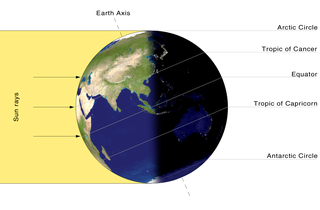Summer solstice
From Wikipedia, the free encyclopedia.
The summer solstice is an astronomical term regarding the position of the sun in relation to the celestial equator. At the time of the summer solstice, the earth is at a point in its orbit where one hemisphere is most tilted towards the sun, causing the sun to appear at 23.45 degrees above the celestial equator, thus making its highest path across the sky. The summer solstice is the day of the year with the longest daylight period and hence the shortest night. This day usually occurs on June 21/June 22 in the northern hemisphere and on December 21/December 22 in the southern hemisphere. The actual date changes due to differences between the calendar year and the tropical year.
The solar term Xiazhi in Chinese astronomy
Xiazhi (夏至) is a solar term begins when Sun lies between the celestial longitude of 90° and 105°. It sometimes refers in particular to the day when Sun exactly at the celestial longitude of 90°. It usually begins around June 21, and ends around July 7.
| Previous: Mangzhong | Solar term | Next: Xiaoshu |
Holidays
The summer solstice along with the winter solstice, vernal equinox, and autumnal equinox were discovered by people in the northern hemisphere and originally referred to northern hemisphere seasons.
Midsummer is the time around the summer solstice. There are traditional holidays celebrated in Northern Europe and elsewhere at this time. In Denmark midsummers eve is known as Sankt Hans Aften. Bonfires are lit on beaches throughout the land as darkness comes and effigies and fireworks are thrown into the fires.
Summer Solstice is also celebrated as a Wiccan sabbat, called Litha. Every year, a celebration takes place at Stonehenge. (See Sun mythology)
In the USA, Canada, Britain and some other countries, the summer solstice is regarded as the start of summer. In other countries, the summer solstice is regarded as midsummer. For example, in Ireland, summer begins on May 1 and ends on July 31. Similary, traditional East Asian calendars (see jieqi) refers to the summer solstice as the "extreme of summer" and not the start. The Slavs celebrate the shortest night of the year as St. John's Night.
External links
- Summer Solstice celebrations at Stonehenge.
- The seasons begin at the time of the solstice or equinox (from the Bad Astronomer)
- Solstice does not signal season's start? (from The Straight Dope)
- Solstice dates and times
- Online Calculator for Dates and Times of Equinoxes and Solstices
- Earth's Seasons, Equinoxes, Solstices, Perihelion, and Aphelion, 1992-2020 (from the United States Naval Observatory's Astronomical Applications Department)
- Plot that shows how the date of the summer solstice shifts through the Gregorian calendar


